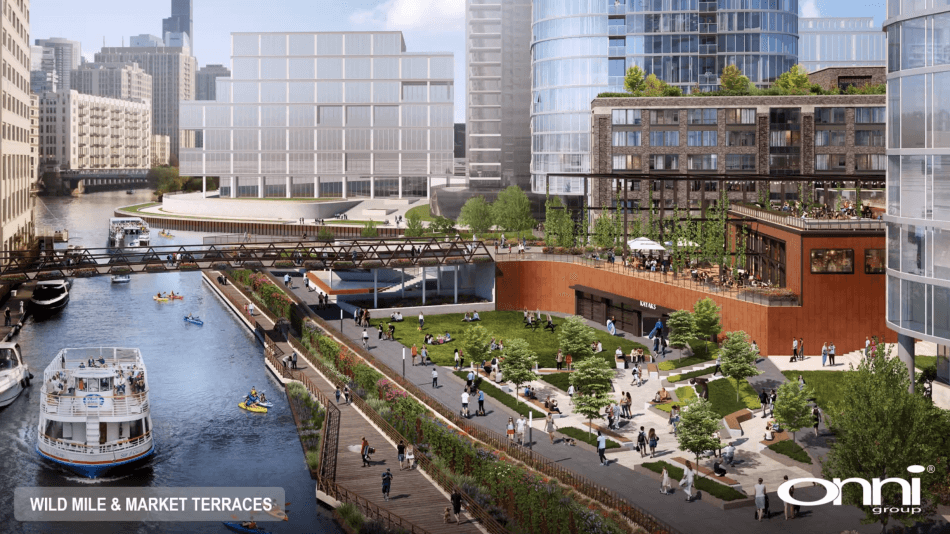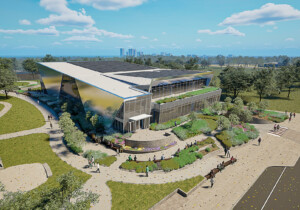The southern tip of Goose Island, a 160-acre artificial island on the northern periphery of downtown Chicago that was once known as Little Hell, could be the future home of a quartet of residential high-rises and a 247-room hotel and 10,000 square feet of office space in a fifth tower.
The cluster of glass-clad apartment towers would rise 56, 55, 46, and 30 stories above the historically industrial—but rapidly evolving—Goose Island landscape while the commercial tower would sit at a slightly squatter 28 stories. The four residential high-rises would collectively add 2,650 new housing units to the Windy City and 20 percent would be earmarked as affordable.
Proposed by the Vancouver, British Columbia-based real estate development behemoth Onni Group, the ambitious, mixed-use redevelopment scheme dubbed Halsted Point would encompass eight acres of land that have remained untouched by residential development for the entirety of its existence. Dominated throughout much of its existence by coal yards, steel mills, gas works, railroads, grain elevators, factories, and its signature flame- and smoke-belching industrial plant chimneys, Goose Island had, once upon a time, been home to sizable housing developments populated by local workers as well as large tracts of open land used for small-scale farming. By the mid-1980s, however, the last of Goose Island’s residents had left with a majority of them fleeing decades earlier.

Halsted Point would find housing—albeit a very different type of housing—return to a part of Goose Island where it had not existed before. Per the Chicago Tribune, the four-phase project would unfold over the course of a decade and breathe new life into a small and prominently situated slice of a gritty, river-bound industrial hub that’s already experienced a flurry of non-residential redevelopment in recent years. Along with the five towers, Onni’s proposal features a pedestrian bridge that would span the Chicago River to directly link the development to the massive, mixed-use 600 West Chicago complex. (A final sign-off from the U.S. Army Corps of Engineers would be needed.) Designed by Chicago’s own Hartshorne Plunkard Architecture, Halsted Point would also include nearly 4 acres of open space including 1,340 feet of shoreline-abutting linear parkland, a spacious social lawn, and a central plaza for hosting community events, farmers markets, and the like. In addition to green space, community amenities would include a fitness center, supermarket, childcare facility, and 1,500 (primarily subterranean) parking spaces.
“Onni is a long-term investor and community builder, and while the pandemic has changed the way we all live and work, we feel confident that our well-designed communities like Halsted Point will continue our ongoing success in world-class cities like Chicago,” Onni said in a statement shared by Crain’s.

With the full blessing of the Chicago City Council and Chicago Plan Commission, Onni hopes to kick off demolition construction work during the first half of 2022 at a site that’s currently home to a Greyhound bus maintenance facility. This first phase would include construction of the 46-story tower and a grocery store with the other towers to follow in subsequent phases. Urbanize Chicago noted that the single commercial tower will be located on the southwestern corner of the development to serve as a buffer of sorts between the new residential towers and its more gritty existing neighbors. Onni purchased the riverside site on the 900 block of North Halsted Street in 2019 for $38 million.
Two years prior in 2017, Chicago eased up on strict, longstanding no-residential zoning rules impacting almost four miles of prime riverfront real estate along the North Branch of the Chicago River, including on Goose Island. In the years since, a handful of mixed-use developments—they include, most notably, the controversial $6 billion Lincoln Yards mega-development just north of Goose Island—have been proposed or are now in the works. As noted by the Tribune, Halsted Point was carved out of the single Goose Island parcel where residential development is permitted under the 2017 zoning changes.
The proposal, which was just unveiled by Onni late last week during a virtual meeting, now must go through the standard approval processes and zoning variances before receiving a final green light. The finalized design could also change based on feedback from area residents and officials. As reported by Crain’s, Onni has offered to pay $28 million into various city funds and programs including the Neighborhood Opportunity Fund “in exchange for the zoning it needs.”











